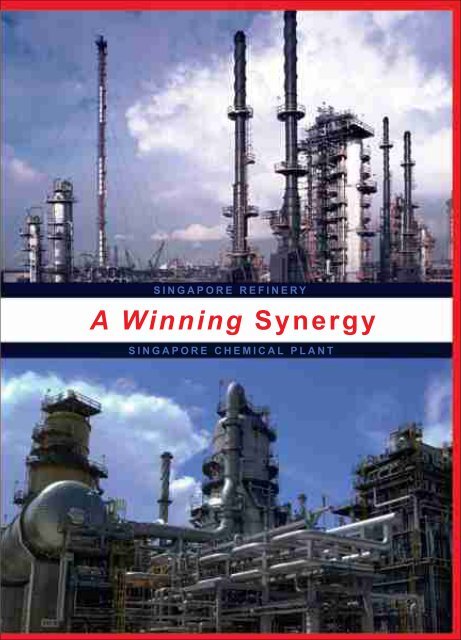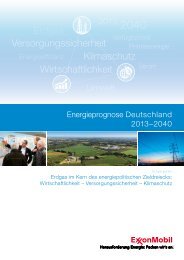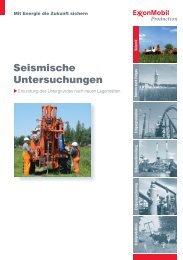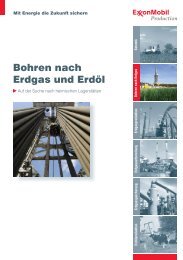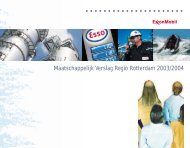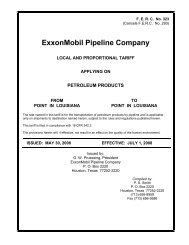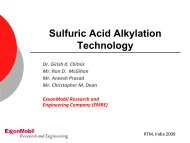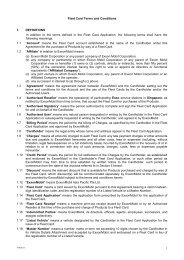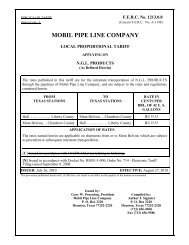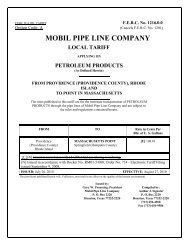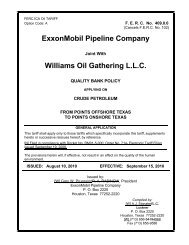A Winning Synergy - ExxonMobil
A Winning Synergy - ExxonMobil
A Winning Synergy - ExxonMobil
You also want an ePaper? Increase the reach of your titles
YUMPU automatically turns print PDFs into web optimized ePapers that Google loves.
SINGAPORE REFINERY<br />
A <strong>Winning</strong> <strong>Synergy</strong><br />
SINGAPORE CHEMICAL PLANT
Singapore Refinery is <strong>ExxonMobil</strong>’s<br />
largest refinery in the World<br />
Introduction<br />
Exxon Mobil Corporation and its affiliates have been operating for over a hundred<br />
years in Singapore, expanding from trading kerosene to a multi-billion dollar manufacturing<br />
and marketing business today. <strong>ExxonMobil</strong> Asia Pacific Pte Ltd ("<strong>ExxonMobil</strong>") is<br />
the single-largest foreign investor in Singapore with US$6.5 billion in assets.<br />
In Singapore, <strong>ExxonMobil</strong> owns and operates a 605,000-barrel-per-day refinery in<br />
Jurong and on Jurong Island. The Singapore Refinery is <strong>ExxonMobil</strong>'s largest<br />
refiney in the World. This operation is fully integrated with the Singapore Chemical<br />
Plant (SCP), a world-class petrochemical complex on Jurong Island. The Singapore<br />
Refinery and SCP, together, form <strong>ExxonMobil</strong>'s largest integrated manufacturing<br />
site in Asia.<br />
The Singapore Refinery and SCP have a committed workforce of about 1,300 employees.<br />
Several integrated departments support both facilities for Safety, Maintenance, Engineering<br />
and Optimisation & Coordination activities.<br />
Nobody Gets Hurt<br />
At <strong>ExxonMobil</strong>, our belief is ‘Nobody Gets Hurt’. In order to live up to this motto, we have developed<br />
an intensive safety plan to look after all who pass through our gates. <strong>ExxonMobil</strong> is committed to<br />
conducting our business in a manner that is compatible with the environmental and economic<br />
needs of all communities in which we operate. These commitments are documented in our<br />
safety, health, environment, product safety and security policies. These policies are put into<br />
practice through a disciplined management framework called Operations Integrity Management<br />
System (OIMS).<br />
OIMS establishes common worldwide expectations for controlling operations integrity risks<br />
inherent in our businesses. Operations integrity addresses all aspects of <strong>ExxonMobil</strong>'s<br />
business, including security that can impact safety, health and environmental performance.
Singapore Chemical Plant<br />
is a world-scale facility employing<br />
state-of-the-art technologies<br />
Environmental Performance<br />
<strong>ExxonMobil</strong> strives to continuously improve our environmental performance. As<br />
part of this commitment, each of our facilities develops site-specific Environmental<br />
Business Plans (EBPs) to complement our corporate environmental plan. The<br />
EBPs are developed to provide a comprehensive, multi-year plan that supports<br />
<strong>ExxonMobil</strong>'s commitment to safe operations and our goal of reducing emissions<br />
while continuing to provide quality products and services to our customers. The<br />
plans are consistent with each site's strategic needs and <strong>ExxonMobil</strong>'s overarching<br />
objective of long term environmental improvement.<br />
Good Corporate Citizen<br />
We make a positive contribution to our host countries and local communities. By<br />
building trust with each community, we believe we will earn the license to operate.<br />
Since 2002, we have worked with the South West Community Development Council<br />
to provide meals throughout the school year for students from needy families.<br />
<strong>ExxonMobil</strong> had our first blood drive in 1999. When we started the blood drive,<br />
it was only targeted at our own employees, contractors and the neighbouring<br />
companies. Year 2003 was the first time that we extended it to the public by<br />
having the blood drive at West Mall - a popular shopping mall in the suburbs.
Singapore Refinery<br />
FACILITY<br />
<strong>ExxonMobil</strong>'s Singapore Refinery has two operating sites - one on the mainland (referred<br />
to as Jurong) and another on Jurong Island (referred to as Pulau Ayer Chawan or PAC) -<br />
occupying 340 hectares of land. Since the Refinery was founded in 1966 for Jurong site and<br />
in 1970 for PAC site, it has grown steadily both in size and complexity. Enhancements over<br />
four decades include conventional Lubes Plant in 1973, Medium Pressure Hydrocracker in<br />
1990, Jurong Aromatics Plant (JAR) in 1994 and Group II Lubes Plant in 1997.<br />
The two sites are interconnected by a host of pipelines to ensure seamless operations and<br />
effective molecule management. The integrated refinery manufactures a wide range of fuels,<br />
lubes and specialty products that are marketed both within Singapore and exported to other<br />
countries in the Asia Pacific region. The Refinery also provides advantaged feedstock to<br />
the steam cracker and two aromatics plants that are located adjacent to the Refinery.<br />
CAPACITY<br />
• 605 KBD of pipestill throughput<br />
• 300 KBD of hydrofining<br />
• 115 KBD of visbreaking<br />
• 80 KBD of reforming<br />
• 33 KBD of hydrocracking<br />
• 31 KBD of lubes<br />
• 1330 KTA of aromatics<br />
- Paraxylene<br />
- Benzene<br />
- Toluene<br />
- Cyclohexane<br />
- Orthoxylene<br />
• 380 KTA of solvents<br />
• 17 Berths<br />
Singapore Refinery<br />
18 Pioneer Road Singapore 628498<br />
Tel: +65 6660 6000 Fax: +65 6264 4529
Crude Oil<br />
Condensate<br />
Overview:<br />
Singapore Refinery Process Overview<br />
Resid<br />
Fuels<br />
Lubes<br />
Naphtha<br />
Mogas<br />
Kero<br />
LPG<br />
Solvents<br />
Diesel<br />
Heavy Gas Oil<br />
Fuel Oil<br />
GP I Lubes<br />
GP II Lubes<br />
Asphalt / Wax<br />
Fuel Oil<br />
The refinery converts the raw material - either<br />
crude oil or condensate into:<br />
a) Finished products that are marketed through<br />
the supply chain e.g. LPG, motor gasoline,<br />
jet fuel, diesel fuel, lubricating oils, bunker fuel<br />
and asphalt.<br />
b) Intermediate / by-products that are consumed<br />
internally as chemical feedstock or fuel e.g.<br />
fuel gas, hydrogen, naphtha, reformate,<br />
distillates and fuel oil.<br />
These raw materials are transformed into<br />
products through a number of unit operations<br />
e.g. fractionation, conversion, treating and<br />
blending.<br />
Naphtha<br />
• Fractionation (physical separation) is the<br />
separation of hydrocarbons in distillation towers<br />
into groups of hydrocarbon compounds of<br />
different boiling-point ranges called "fractions"<br />
or "cuts".<br />
Aromatics<br />
Steam Cracker<br />
Paraxylene<br />
Benzene<br />
Cyclohexane<br />
Orthoxylene<br />
Toluene<br />
Aromatics Solvents<br />
• Conversion (chemical reaction) changes the<br />
size and/or structure of the hydrocarbon<br />
molecules. Conversion may result in a<br />
decomposition, unification or isomerisation of<br />
the feed molecules.<br />
• Treating processes (physical separation and/or<br />
chemical reactions) prepare hydrocarbon<br />
streams for additional processing or finishing<br />
operations. It involves the removal or separation<br />
of impurities and other undesirable components.<br />
• Blending is the process of mixing and combining<br />
hydrocarbon fractions, additives and other<br />
components to produce finished products with<br />
specific performance properties.<br />
These processes are supported by other activities<br />
like oil movement, utility generation / distribution<br />
and effluent treatment.
Singapore Refinery: Fuels<br />
Products and their end uses:<br />
LPG<br />
• Used as a clean domestic / commercial fuel for<br />
heating and cooking as well as fuel for motor<br />
vehicles.<br />
Naphtha<br />
• Feedstock destined for motor gasoline and<br />
petrochemicals industry (e.g. ethylene manufacture<br />
or aromatics production).<br />
Motor Gasoline<br />
• Commonly used as a fuel in motor vehicles.<br />
• Additives are often used to enhance performance<br />
and provide protection against oxidation and rust<br />
formation.<br />
Kerosene / Jet Fuel<br />
• A refined middle-distillate product that is used as<br />
a jet fuel, domestic heating and to manufacture<br />
solvents.<br />
Gas Oil / Diesel<br />
• Used as motor fuel for compression ignition (buses,<br />
trucks, marine) and light heating oil for industrial<br />
and commercial application.<br />
Heavy Fuel Oil Residual<br />
• Many power plants, commercial buildings and<br />
industrial facilities use fuel oil for heating and<br />
processing.<br />
• Fuel oil is also used to power marine vessels.<br />
Technology characteristics<br />
• The Singapore Refinery is a world-scale refining<br />
complex. Together with the Singapore Chemical<br />
Plant, it forms the largest integrated <strong>ExxonMobil</strong><br />
manufacturing complex in Asia. As a worldwide<br />
supplier of refined products, such interconnectivity<br />
allows us to be flexible and respond quickly to<br />
the market.
Singapore Refinery: Lubes & Specialties<br />
Products and their end uses:<br />
Lube Basestocks (Group I & II)<br />
• Hydrocarbons produced from heavy distillate; used<br />
mainly as lubricants.<br />
• Group I basestocks are conventional basestocks<br />
manufactured via solvent refining techniques while<br />
Group II basestocks are made through hydrocracking<br />
/ hydroisomerisation technology.<br />
• Additives such as demulsifiers, antioxidants and<br />
viscosity improvers are added to enhance the<br />
performance of motor oils, industrial greases,<br />
industrial oils and lubricants.<br />
Asphalt<br />
• Solid, semi-solid or viscous hydrocarbon, obtained<br />
through the distillation of crude oil.<br />
• Asphalt is primarily used for surfacing of roads and<br />
for roofing material as it is resistant to most chemicals<br />
and weather conditions.<br />
Paraffin Waxes<br />
• Waxes are residues extracted from Group I Lubes<br />
and they have a crystalline structure, are pale yellow<br />
to white (or colourless).<br />
• Wide uses in food packaging, water proofing for<br />
paper and textile, candle making and cosmetics,<br />
after additional processing.<br />
Solvents<br />
• Used as a cleaning agent and in the manufacture<br />
of a variety of paints, glues and enamels.<br />
Technology characteristics<br />
• Group II Lubes plant was built using state-of-theart<br />
<strong>ExxonMobil</strong> technology and <strong>ExxonMobil</strong><br />
proprietary catalyst. This produces lubes base stock<br />
with improved thermal and oxidation stability, low<br />
temperature properties and volatility resulting in<br />
higher fuel economy, better engine protection, lower<br />
oil consumption, extended lubricant life and<br />
sustained emissions performance.
JAR: Jurong Aromatics Plant<br />
Production<br />
• 400 KTA Paraxylene<br />
• 300 KTA Benzene<br />
• 250 KTA Cyclohexane<br />
• 200 KTA Orthoxylene<br />
• 180 KTA Toluene<br />
Products and their end uses:<br />
Paraxylene and Benzene same as Singapore<br />
Aromatics Plant (SAR).<br />
Cyclohexane<br />
• Used in making nylon, to manufacture end<br />
products such as textile, carpets and auto parts.<br />
Orthoxylene<br />
• Orthoxylene is a raw material for making alkaline<br />
resins and plasticisers.<br />
Toluene<br />
• Used in motor gasoline, feed to generate more<br />
xylenes and benzene molecules and making<br />
chemical derivatives.<br />
Technology Characteristics<br />
• JAR is one of <strong>ExxonMobil</strong>'s biggest aromatics<br />
plants in Asia. Its key strength is the flexibility<br />
to optimise product slates according to market<br />
conditions. It is also highly integrated with<br />
Singapore Aromatics Plant and Singapore<br />
Refinery.
Singapore Chemical Plant<br />
FACILITY<br />
Singapore Chemical Plant (SCP) is <strong>ExxonMobil</strong> Chemical’s largest investment (US$2 billion)<br />
in the Asia Pacific. This world-scale facility employs state-of-the-art chemical processing<br />
technologies for high-performance manufacturing in today’s competitive global chemicals<br />
market. Comprising five integrated units, this highly synergised plant serves as a strategic<br />
supply pillar for the region.<br />
Consistent with <strong>ExxonMobil</strong>’s worldwide operational standards, SCP is committed to<br />
protecting the safety and health of our employees, the communities in which we operate,<br />
and the environment. In addition, we are committed to maintaining the highest level of<br />
customer focus through world-class performance in operational and supply reliability. SCP<br />
is owned by <strong>ExxonMobil</strong> Asia Pacific Pte Ltd. Ground breaking took place in 1998 and the<br />
plant was commissioned in 2001. SCP is located on 90 hectares of mostly reclaimed land<br />
on Jurong Island.<br />
CAPACITY<br />
• 900 KTA of ethylene<br />
• 435 KTA of propylene<br />
• 270 KTA of n-butylene<br />
• 80 KTA of MTBE<br />
• 480 KTA of polyethylene<br />
• 315 KTA of polypropylene<br />
• 35 KBD of reforming<br />
• 420 KTA of paraxylene<br />
• 190 KTA of benzene<br />
• 220 KTA of oxo alcohol<br />
• 35 KTA of isopar<br />
Singapore Chemical Plant<br />
100 Jurong Island Highway Singapore 627867<br />
Tel: +65 6586 6000 Fax: +65 6586 6119
Overview:<br />
•<br />
•<br />
•<br />
•<br />
•<br />
Feedstock<br />
from<br />
<strong>ExxonMobil</strong><br />
Asia Pacific<br />
Refineries<br />
* Selective Hydrogenation Unit<br />
** Gasoline Hydrogenation Unit<br />
*** Partial Oxidation Unit<br />
SCP Process Overview<br />
Steam<br />
Cracker<br />
The Singapore Chemical Plant (SCP) consists of<br />
five plants namely: Oxo alcohol, Olefins, Aromatics,<br />
Polypropylene and Polyethylene Plants.<br />
It is fully integrated with our Singapore Refinery.<br />
The heart of the facility is a world-scale steam<br />
cracker producing mainly ethylene and propylene.<br />
The majority of feedstocks are consumed by our<br />
four derivative plants. The site also has facilities<br />
for importing and exporting these monomers.<br />
The steam cracker receives feed from <strong>ExxonMobil</strong><br />
refineries and other sources in Asia Pacific.<br />
SCP also generates all its own electricity and<br />
steam through cogeneration.<br />
C2<br />
C3<br />
C4s<br />
C5-C7<br />
Fuel Oil<br />
SHU*/<br />
MTBE<br />
GHU**<br />
POX***<br />
•<br />
•<br />
•<br />
•<br />
Polyethylene<br />
Plant<br />
Polypropylene<br />
Plant<br />
Oxo alcohol<br />
Plant<br />
Cogen<br />
Aromatics<br />
Plant<br />
PE Prod<br />
Sales<br />
PP Prod<br />
Sales<br />
Oxo alcohols<br />
Mogas<br />
Steam<br />
Power<br />
Fuel Oil<br />
Benzene<br />
Paraxylene<br />
The Oxo alcohol Plant produces Isononyl Alcohol,<br />
or INA in short, which is used to make plasticisers<br />
that are used to make PVC plastic flexible.<br />
The Polypropylene and Polyethylene produce<br />
thermoplastics which are used by our customers<br />
to produce a wide variety of finished products.<br />
Our Aromatics Plant produces paraxylene and<br />
recovers benzene from the feed streams it receives<br />
from the Olefins Plant and refineries. Paraxylene<br />
and benzene are intermediate chemicals used by<br />
our customers to produce polyester and a wide<br />
variety of other products.<br />
Units within the SCP also produce components<br />
of motor gasoline. These components are used<br />
in our refineries.
Production<br />
• 900 KTA ethylene, 435 KTA propylene<br />
• 270 KTA n-butylene, 80 KTA MTBE<br />
Products and their end uses:<br />
Ethylene<br />
• Basic building-block for making a wide variety<br />
of chemical and polymer products, including<br />
polyethylene.<br />
• Used in plastic packaging, containers, films,<br />
detergents, cosmetics and paints.<br />
Propylene<br />
• Basic building-block for making polypropylene,<br />
polymers and other chemicals.<br />
• Used in carpeting, upholstery, pleasure boats<br />
and automotive parts.<br />
Normal Butylene<br />
• Basic building-block for making butyl rubber,<br />
polymers and other chemicals.<br />
• Used in tyre liners and vinyl intermediates.<br />
MTBE<br />
• Used as an octane enhancer / anti-knock agent<br />
for petrol.<br />
SOP: Singapore Olefins Plant<br />
Technology characteristics<br />
• The steam cracker is the core of the integrated<br />
site. Built using advanced <strong>ExxonMobil</strong><br />
technology, the highly-efficient furnaces ‘crack’<br />
both light and heavy feed to produce basic<br />
molecules like ethylene, propylene and<br />
butylene. These are then transformed into<br />
other products such as polyolefins. The<br />
residues from this process are used to produce<br />
syngas that is used as feed for the oxo alcohol<br />
plant, and to power the cogeneration unit for<br />
the production of steam and electricity for<br />
the site.
Production<br />
• 480 KTA polyethylene<br />
• 315 KTA polypropylene<br />
Products and their end uses:<br />
Polyethylene<br />
• Basic plastic, in the form of resin pellets, derived<br />
from ethylene.<br />
• Used in packaging material, bread wrappers,<br />
garbage bags and electrical insulation. Also used<br />
in the agricultural film market to facilitate early crop<br />
yield.<br />
Polypropylene<br />
• Basic plastic, in the form of resin pellets, derived<br />
from propylene.<br />
• Used in carpeting, upholstery, film, car seats, battery<br />
cases and automotive parts.<br />
SPO: Singapore Polyolefins Plant<br />
Technology characteristics<br />
• SPO [comprising both the Singapore Polyethylene<br />
Plant (SPE) and the Singapore Polypropylene Plant<br />
(SPP)] has the largest single-line Unipol plant - the<br />
world’s largest extruder and pelletiser. SPE utilises<br />
the cutting-edge “Univation super condensed mode”<br />
technology to increase throughput beyond that<br />
which is available to all other Unipol plants.
Production<br />
• 220 KTA Oxo alcohol<br />
• 35 KTA Isopar<br />
Products and their end uses:<br />
Isononyl Alcohol<br />
• Feedstock for the manufacture of plasticisers<br />
which provide flexibility/elasticity to many<br />
products.<br />
• Plasticised PVC is used in floor and wall<br />
coverings, wire and cable insulation, synthetic<br />
leathers, automotive applications and medical<br />
products.<br />
Isopar<br />
• Carrier fluids for household products like<br />
degreasers and detergents.<br />
• Used in aerosol insecticides, printing inks and<br />
reaction diluents.<br />
SPA: Singapore Oxo alcohol Plant<br />
Technology characteristics<br />
• SPA utilises <strong>ExxonMobil</strong> cobalt flash technology<br />
and feeds on the butylene stream produced<br />
by the steam cracker. It supplies to customers<br />
across Asia, including <strong>ExxonMobil</strong>’s own<br />
plasticiser plants in the region. SPA’s hightech<br />
laboratory features the latest testing<br />
equipment. It employs advanced on-line and<br />
off-line analytics facilities to ensure reliable<br />
and consistently on-specification production.
Production<br />
• 35 KBD Reforming<br />
• 420 KTA Paraxylene<br />
• 190 KTA Benzene<br />
Products and their end uses:<br />
Paraxylene<br />
• Used to make polyesters [including<br />
polyethylene terephthlate (PET)] which are<br />
commonly applied in clothings,<br />
packaging, car tyre rods and plastic bottles.<br />
• Used in x-ray, video and audio tapes films.<br />
Benzene<br />
• Key basic chemical for manufacture of a wide<br />
range intermediate products, including<br />
cycloxhexane that makes nylon. Nylon is used<br />
in everyday items such as stockings, rope and<br />
plastic toys.<br />
• Makes styrene which is used to manufacture<br />
polystyrene and rubber products.<br />
• Makes cumene and phenol which are used in<br />
health care products such as aspirin and<br />
penicillin, as well as epoxy resins.<br />
SAR: Singapore Aromatics Plant<br />
Technology characteristics<br />
• SAR is designed as one of the largest<br />
paraxylene trains. It uses the UOP Parex<br />
technology to produce paraxylene and the<br />
UOP sulfolane technology to make benzene.<br />
These cutting edge technologies allow efficient<br />
production of high-purity products to meet<br />
the demands of customers.


